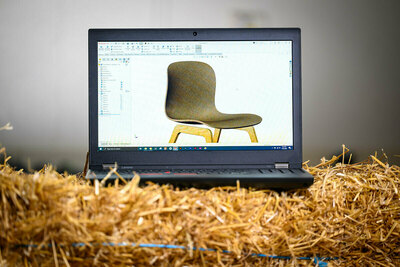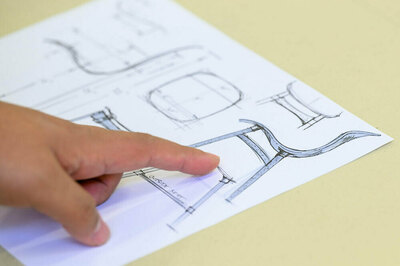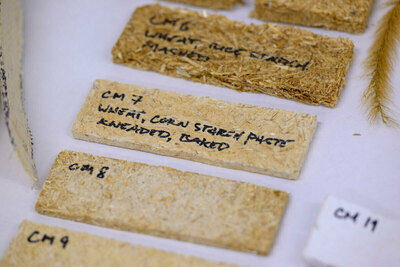
Jason Carley ’10 started his career as an industrial designer for a client roster of corporate heavyweights — Disney, Philips, SC Johnson, The Home Depot, Dell, Abbott and Whirlpool.
He also helped make a personal-security device that won investor support on the TV show Shark Tank.
But three years ago, his focus shifted to environmental impact.
“The pandemic happened, so all of a sudden, everybody begins to question ‘What am I doing with my life?’ That was the kick in the pants where I realized I wasn’t totally satisfied with what I was doing day to day,” he said. “You think you could be doing work that is more important to the needs the world has.
“And I thought as an industrial designer, we are perfectly situated to work on this challenge where our means of production and transportation emit a lot of carbon. We make and rely on a lot of plastic, which ends up being discarded and becomes waste. But we have a lot of creativity. We have great positions as a liaison between business and manufacturing and the service industry. So we’re really well-positioned to effect change. I just didn’t really know how to do it.”

He found his answer by going back to school, and now will earn a Master of Fine Arts in Industrial Design this spring through Notre Dame’s Department of Art, Art History & Design. He’s also part of the GLOBES Program in the Reilly Center for Science, Technology, and Values, which brings together graduate students seeking new and innovative ways to address the environmental challenges facing humankind and the planet.
The first product he’s designed and developed is a chair — potentially suitable for classrooms and lecture halls — made from plants and other natural resources.
The burlap seat is derived from jute fiber and held together with a gelatin-based bio-resin. The legs and trusses are made of wheat straw secured with a bioplastic glue made from corn starch and glycerin. And the dye that provides the color is a mix of walnut husk and madder root.
This work is regenerative, meaning it’s a step up from environmental sustainability. Not only do the materials avoid environmental harm, they can be grown again on the same ground. And when the chair’s use ends, it would turn into dirt if left outside. There’s no need for a landfill.
Carley approaches the work with a foundation that design is a mindset — not an exercise.
“Design requires you to question everything around you. It’s really about problem-solving,” he said. “You have to keep an open mind and think outside the box because so often you’re working in unexplored territory. That’s why you hire a designer — you’re trying to figure out new ways of doing things.”
His mindset is also gravitating toward a vision of the future in which the relationship between products is improved. This would enable certain products to match the lifetime of the things they support.
“A good example is food packaging. If something should only be in the grocery store for a week or two to stay fresh, you can use a certain kind of packaging,” he said. “Plastic lasts hundreds of years, but we use it to wrap produce that lasts two weeks.”
“Design requires you to question everything around you. It’s really about problem-solving. You have to keep an open mind and think outside the box because so often you’re working in unexplored territory. That’s why you hire a designer — you’re trying to figure out new ways of doing things.”
Pushing in different directions
After graduating from Notre Dame in 2010 with majors in mechanical engineering and design through the Reilly Dual Degree Program, Carley began his career at a consulting firm working on health-care product design.
He developed strong relationships with other engineers and artists who launched tech and smart-home products in 2014 out of a warehouse in Chicago. They needed investors.
“Companies and startups were cashing in on these pre-orders for products that didn’t exist yet, and we thought we could do the same thing,” Carley said. “We had some cool ideas, but none of us knew anything about business, so they didn’t get off the ground. We shopped around to investors but couldn’t build momentum.”

Though not initially a financial success, the effort proved to be a happy accident when the group started leasing workspace and mentorship to the public. Today, the building just west of downtown Chicago is known as mHub, a community that has raised more than $1 billion in capital and launched about 1,400 products.
At mHub, Carley helped design a small device that people could keep in their pockets with a button to press if they’re in distress or danger. The device communicates to a smartphone app to alert emergency responders without the user having to handle their phone. That project won financial backing on Shark Tank.
After three years at the makerspace, Carley returned to consulting with a company that developed virtual-reality equipment, entertainment attractions, and manufacturing and industrial equipment.
Now back in the classroom, he appreciates the independence to create in a community of divergent ideas.
“That’s what’s been so fun about being back in academia after being in industry for a while. In industry, everybody marches to the beat of the same drum. You get to know people individually, but usually those types of research, focuses or interests, they kind of fade over time,” he said. “But in academia, that’s the focus of your work. Everybody is pursuing their own directions and working on important topics. And that’s inspiring and encouraging that you’re around people that are pushing in all these different directions.”
Moving the needle
Carley’s goal — to design and build in a way that helps the environment — means that he is conscious that plastic, paint, and adhesive come from a nonrenewable source. The timber and wood that is turned into paper, tissue and plywood comes from forests that, for the most part, are not sustainably managed.
For his new type of chair, he’s found ways to make it comfortable, supportive, and structurally sound while still being regenerative. The chair features a built-in recline thanks to the flexibility of the material, and instead of using trees for a wooden structure, the straw can be grown every year. Its mass production would lower the load on landfills and reduce the number of factory workers exposed to the epoxy resin that is damaging to inhale.

Before beginning to build the chair, Carley prepares his materials using ancient techniques. He places the plants in a pyramid shape to dry in the sun. Rainfall sheds off the outer layer, allowing the materials inside to dry. This is an alternative to sending plywood through massive ovens to dehydrate, which creates emissions.
In addition to the chair, Carley is developing new types of cinder blocks and roofing shingles because, he acknowledged, “a single chair is not going to move the needle.”
“What will move the needle is commodities in the building industry and packaging industry,” he said. “If you can get some of that into the market and build homes out of straw and bioplastic instead of things like concrete, which requires a huge amount of energy to create, you would start to see a big impact.”
Carley’s chair will be on display at the South Bend Museum of Art this month.
“Hopefully I’ll have a chair anybody can sit in, and it’s made of materials that haven’t been used before,” Carley said. “It’s been such a cool, challenging journey to develop this way of working and analyze how we produce these goods — the things we take for granted and constraints I had on the project. Like hitting a challenge and knowing I can’t just reach for paint or polyurethane, and I have to come up with something else. That’s been fun, and it makes me excited for this body of research and where this style of making can go in the future.”


